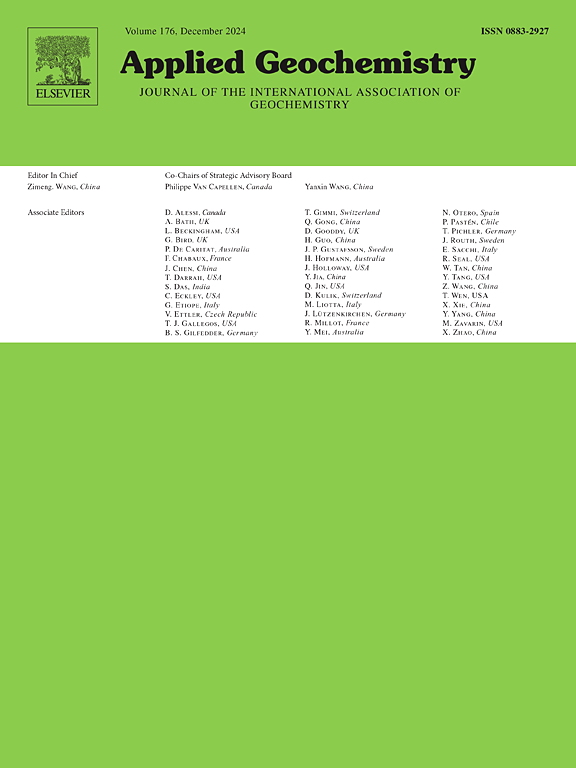东埃及沙漠的地下水:年龄和盐度模式
IF 3.4
3区 地球科学
Q1 GEOCHEMISTRY & GEOPHYSICS
引用次数: 0
摘要
随着红海沿岸依赖地下水的灌溉项目和海水淡化活动的日益发展,人们对其补给机制和驱动盐度变化的地球化学过程提出了疑问。为了解决这些问题,我们对红海山沿线的几口井和泉水进行了取样和分析,以测定放射性碳、氚、δ13C、δ18O、δ2H及其化学成分。在2019-2021年的同一时期,从该地区的零星降雨事件中收集了降雨和洪水样本。根据地球化学组成和同位素特征,将采样地点在地理上聚类并划分为6种不同的地下水类型。不同的类型表现出不同的地球化学和同位素特征,反映了不同的流动路径、补给周期和岩性相互作用。Wadi Araba淡水泉具有最小盐渍化和轻稳定同位素特征,提示更新世补给。这些泉水从裂缝中冒出来,受到下伏努比亚砂岩中含钠矿物风化作用的影响。相比之下,沿海平原的地下水显示出海水蒸发盐水的显著贡献,其同位素特征遵循蒸发趋势。这些水的年龄变化很大,从近代到更新世,表明尽管流动路径不同,但岩石相互作用相似。另一类地下水主要受岩盐、石膏和白云岩风化作用的影响,没有明显的卤水贡献。高盐地下水是罕见的,突出的极端盐水贡献可能来自深层地壳构造。在Wadi Araba和红海丘陵地区发现的Na/Cl比值升高的地下水,反映了岩浆岩或碎屑砂岩中的长石等含钠矿物的风化作用。这些水与受海水或蒸发盐水影响的水形成鲜明对比,突出了岩性、补给过程和构造活动在形成该地区地下水系统中的复杂相互作用。本文章由计算机程序翻译,如有差异,请以英文原文为准。
Groundwater of the Eastern Egyptian Desert: age and salinity patterns
The increasing development of groundwater dependent irrigation projects and desalination activities along the Red Sea coast raises questions about its recharge mechanisms and the geochemical processes driving salinity variations. To address these questions, several wells and springs, along the Red Sea Hills have been sampled and analysed for radiocarbon, tritium, δ13C, δ18O, δ2H and their chemistry. For the same period between 2019-2021, rain and floodwater samples have been collected from sporadic rain events in the region. The sampling locations are geographically clustered and classified into six distinct groundwater types based on geochemical composition and isotopic signatures. The distinguished types exhibits a diverse range of geochemical and isotopic characteristics, reflecting variable flow paths, recharge periods, and lithological interactions. Freshwater springs in Wadi Araba are characterized by minimal salinization and light stable isotopes, suggesting Pleistocene recharge. These springs, emerge from fractures and are influenced by the weathering of Na-bearing minerals in the underlying Nubian Sandstone. In contrast, groundwater from the coastal plain shows significant contributions from seawater evaporation brines, with isotopic signatures following an evaporation trend. These waters vary widely in age, from recent to Pleistocene, indicating similar lithological interactions despite differing flow paths. Another group of groundwater is influenced primarily by the weathering of halite, gypsum, and dolostone, showing no significant brine contribution. Highly saline groundwater are rare and stands out with extreme brine contributions likely sourced from deep crustal formations. Groundwater with elevated Na/Cl ratios, found in regions of Wadi Araba and the Red Sea Hills, reflects the weathering of Na-bearing minerals such as feldspars in magmatic rocks or clastic sandstones. These waters contrast sharply with those influenced by seawater or evaporation brines, highlighting the complex interplay of lithology, recharge processes, and tectonic activity in shaping the region’s groundwater systems.
求助全文
通过发布文献求助,成功后即可免费获取论文全文。
去求助
来源期刊

Applied Geochemistry
地学-地球化学与地球物理
CiteScore
6.10
自引率
8.80%
发文量
272
审稿时长
65 days
期刊介绍:
Applied Geochemistry is an international journal devoted to publication of original research papers, rapid research communications and selected review papers in geochemistry and urban geochemistry which have some practical application to an aspect of human endeavour, such as the preservation of the environment, health, waste disposal and the search for resources. Papers on applications of inorganic, organic and isotope geochemistry and geochemical processes are therefore welcome provided they meet the main criterion. Spatial and temporal monitoring case studies are only of interest to our international readership if they present new ideas of broad application.
Topics covered include: (1) Environmental geochemistry (including natural and anthropogenic aspects, and protection and remediation strategies); (2) Hydrogeochemistry (surface and groundwater); (3) Medical (urban) geochemistry; (4) The search for energy resources (in particular unconventional oil and gas or emerging metal resources); (5) Energy exploitation (in particular geothermal energy and CCS); (6) Upgrading of energy and mineral resources where there is a direct geochemical application; and (7) Waste disposal, including nuclear waste disposal.
 求助内容:
求助内容: 应助结果提醒方式:
应助结果提醒方式:


